2009 CHEVROLET CORVETTE instrument cluster
[x] Cancel search: instrument clusterPage 168 of 434
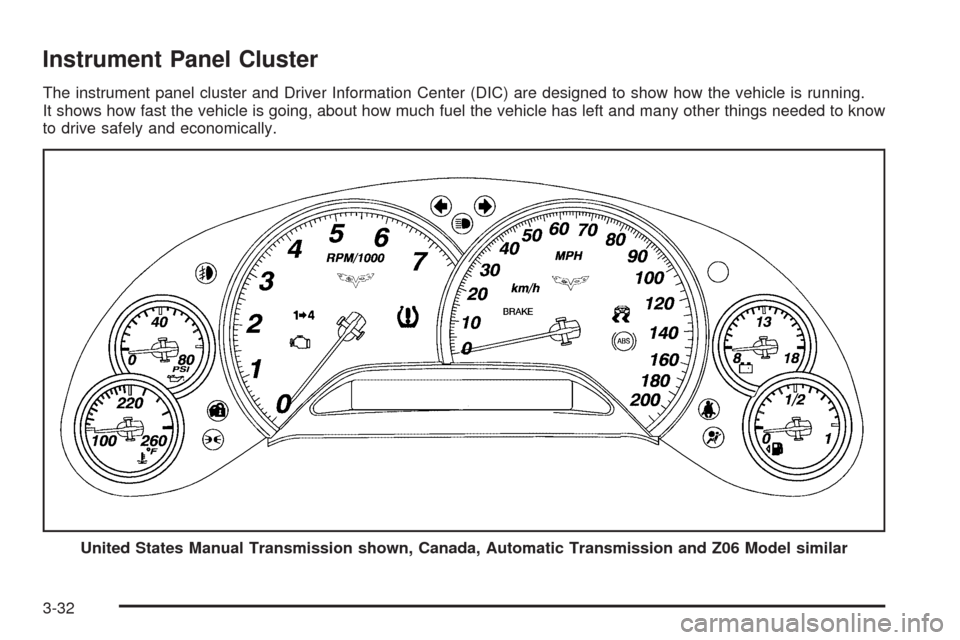
Instrument Panel Cluster
The instrument panel cluster and Driver Information Center (DIC) are designed to show how the vehicle is running.
It shows how fast the vehicle is going, about how much fuel the vehicle has left and many other things needed to know
to drive safely and economically.
United States Manual Transmission shown, Canada, Automatic Transmission and Z06 Model similar
3-32
Page 173 of 434
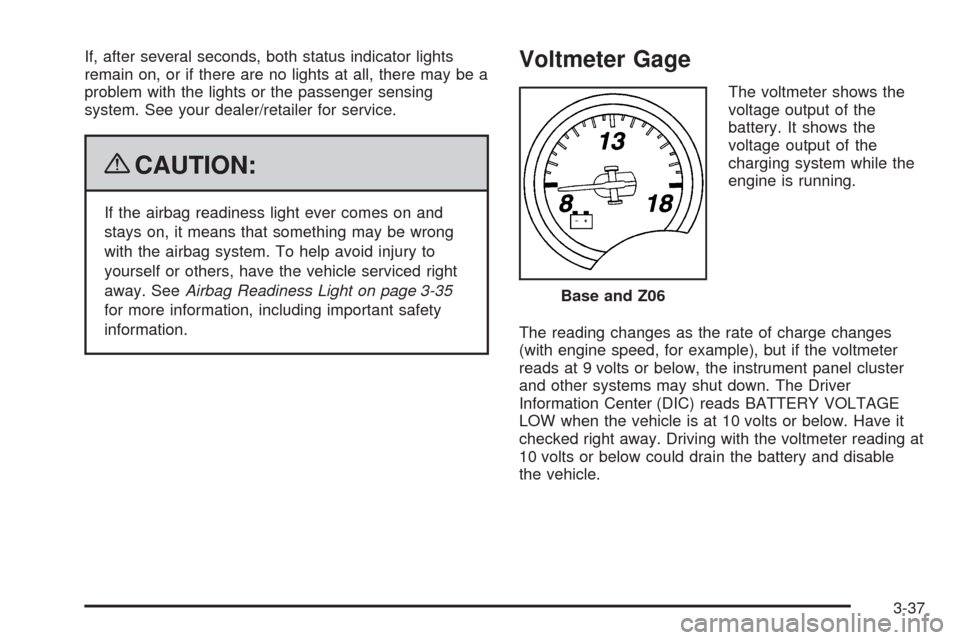
If, after several seconds, both status indicator lights
remain on, or if there are no lights at all, there may be a
problem with the lights or the passenger sensing
system. See your dealer/retailer for service.
{CAUTION:
If the airbag readiness light ever comes on and
stays on, it means that something may be wrong
with the airbag system. To help avoid injury to
yourself or others, have the vehicle serviced right
away. SeeAirbag Readiness Light on page 3-35
for more information, including important safety
information.
Voltmeter Gage
The voltmeter shows the
voltage output of the
battery. It shows the
voltage output of the
charging system while the
engine is running.
The reading changes as the rate of charge changes
(with engine speed, for example), but if the voltmeter
reads at 9 volts or below, the instrument panel cluster
and other systems may shut down. The Driver
Information Center (DIC) reads BATTERY VOLTAGE
LOW when the vehicle is at 10 volts or below. Have it
checked right away. Driving with the voltmeter reading at
10 volts or below could drain the battery and disable
the vehicle.Base and Z06
3-37
Page 185 of 434

Boost Gage (ZR1 Only)
For vehicles that have this gage, it is located near the
driver side of the instrument panel cluster.
This gage indicates vacuum during light to moderate
throttle and boost under heavier throttle.
It displays the air pressure level in the intake manifold
before it enters the engine’s combustion chamber.
The gage is automatically centered at zero every time
the engine is started. Actual vacuum or boost is
displayed from this zero point. Changes in ambient
pressure, such as driving in mountains and changing
weather, will slightly change the zero reading.
Driver Information Center (DIC)
The Driver Information Center (DIC) display is located
on the instrument panel cluster and shows driver
personalization features and warning/status messages.
The DIC buttons are located on the instrument panel,
to the right of the cluster.
The DIC comes on when the ignition is turned on.
After displaying CORVETTE BY CHEVROLET, the DIC
shows the information that was last displayed before
the engine was turned off.
If a problem is detected, a warning message appears
on the DIC display. SeeDIC Warnings and Messages
on page 3-54for more information.
DIC Operation and Displays
Depending on the features on the vehicle, the drive
gear may display on the DIC. See “Manual Paddle Shift”
underAutomatic Transmission Operation on page 2-26
and “Head-Up Display (HUD)” in the index of the
Navigation system manual for more information. United States
Canada
3-49
Page 186 of 434
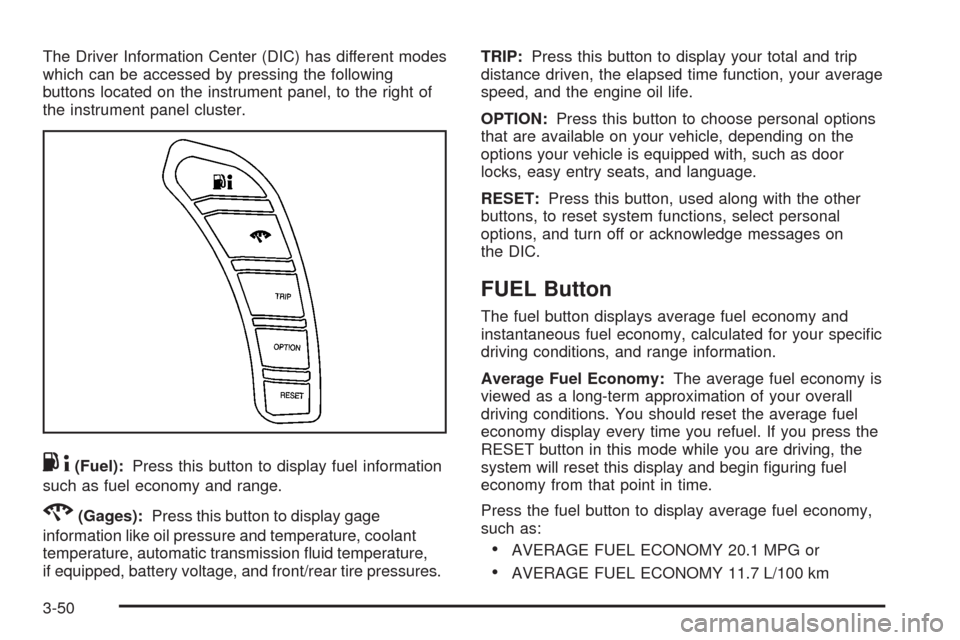
The Driver Information Center (DIC) has different modes
which can be accessed by pressing the following
buttons located on the instrument panel, to the right of
the instrument panel cluster.
.4(Fuel):Press this button to display fuel information
such as fuel economy and range.
2(Gages):Press this button to display gage
information like oil pressure and temperature, coolant
temperature, automatic transmission �uid temperature,
if equipped, battery voltage, and front/rear tire pressures.TRIP:Press this button to display your total and trip
distance driven, the elapsed time function, your average
speed, and the engine oil life.
OPTION:Press this button to choose personal options
that are available on your vehicle, depending on the
options your vehicle is equipped with, such as door
locks, easy entry seats, and language.
RESET:Press this button, used along with the other
buttons, to reset system functions, select personal
options, and turn off or acknowledge messages on
the DIC.
FUEL Button
The fuel button displays average fuel economy and
instantaneous fuel economy, calculated for your speci�c
driving conditions, and range information.
Average Fuel Economy:The average fuel economy is
viewed as a long-term approximation of your overall
driving conditions. You should reset the average fuel
economy display every time you refuel. If you press the
RESET button in this mode while you are driving, the
system will reset this display and begin �guring fuel
economy from that point in time.
Press the fuel button to display average fuel economy,
such as:
AVERAGE FUEL ECONOMY 20.1 MPG or
AVERAGE FUEL ECONOMY 11.7 L/100 km
3-50
Page 192 of 434

BUCKLE PASSENGER
This message reminds you to buckle the passenger’s
safety belt.
This message displays and a sound will be heard when
the ignition is on, the driver’s safety belt is buckled, the
passenger’s safety belt is unbuckled with the passenger
airbag enabled, and the vehicle is in motion. You should
have the passenger buckle their safety belt.
The reminder will be repeated if the ignition is on, the
vehicle is in motion, the driver is buckled and the
passenger is still unbuckled, and the passenger airbag
is enabled. If the passenger’s safety belt is already
buckled, this message will not come on.
BUCKLE SEATBELT
This message reminds you to buckle the driver’s
safety belt.
This message displays and a sound will be heard when
the ignition is on, the driver’s safety belt is unbuckled,
and the vehicle is in motion. You should buckle your
safety belt.
If the driver remains unbuckled when the ignition is on
and the vehicle is in motion, the reminder will be
repeated. If the driver’s safety belt is already buckled,
this message will not come on.This message is an additional reminder to the safety
belt reminder light in the instrument panel cluster.
SeeSafety Belt Reminders on page 3-34for more
information.
CHANGE BRAKE PADS
On vehicles with electronic brake pad wear sensors,
this message will be displayed when the pads are worn.
See your dealer/retailer for service.
CHANGE ENGINE OIL
This message displays when the life of the engine oil
has expired. SeeScheduled Maintenance on page 6-4.
After an oil change, the engine oil life system must
be reset. See “Engine Oil Life” underDIC Operation
and Displays on page 3-49. Also, seeEngine Oil
on page 5-20andEngine Oil Life System on page 5-26
for more information.
CHECK BRAKE FLUID
This message displays, a sound will be heard, and the
brake system warning light on the instrument panel
cluster turns on if the ignition is on to inform the driver
that the brake �uid level is low. SeeBrake System
Warning Light on page 3-38. Have the brake system
serviced by your dealer/retailer as soon as possible.
SeeBrakes on page 5-44.
3-56
Page 193 of 434
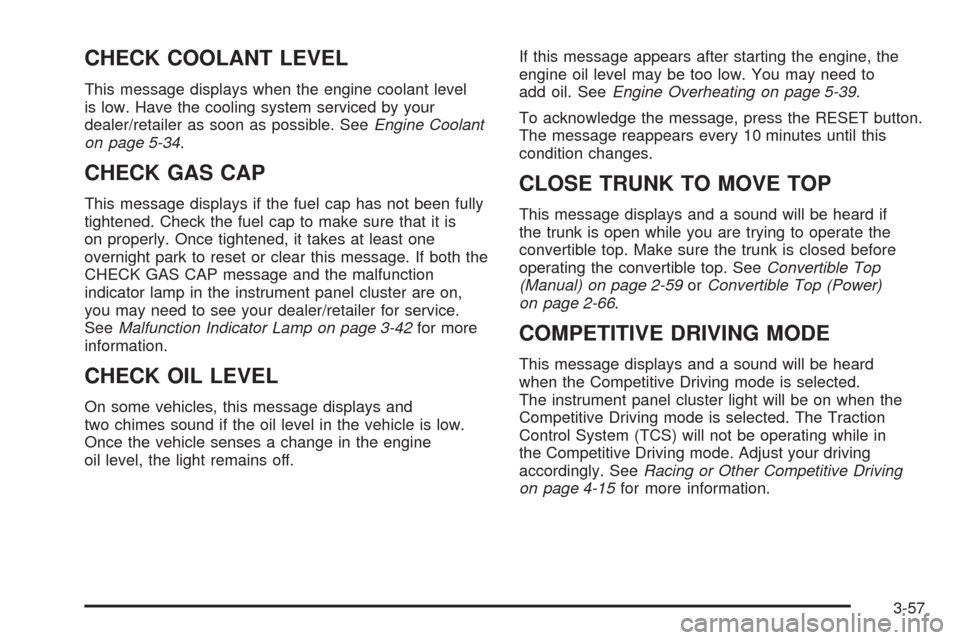
CHECK COOLANT LEVEL
This message displays when the engine coolant level
is low. Have the cooling system serviced by your
dealer/retailer as soon as possible. SeeEngine Coolant
on page 5-34.
CHECK GAS CAP
This message displays if the fuel cap has not been fully
tightened. Check the fuel cap to make sure that it is
on properly. Once tightened, it takes at least one
overnight park to reset or clear this message. If both the
CHECK GAS CAP message and the malfunction
indicator lamp in the instrument panel cluster are on,
you may need to see your dealer/retailer for service.
SeeMalfunction Indicator Lamp on page 3-42for more
information.
CHECK OIL LEVEL
On some vehicles, this message displays and
two chimes sound if the oil level in the vehicle is low.
Once the vehicle senses a change in the engine
oil level, the light remains off.If this message appears after starting the engine, the
engine oil level may be too low. You may need to
add oil. SeeEngine Overheating on page 5-39.
To acknowledge the message, press the RESET button.
The message reappears every 10 minutes until this
condition changes.
CLOSE TRUNK TO MOVE TOP
This message displays and a sound will be heard if
the trunk is open while you are trying to operate the
convertible top. Make sure the trunk is closed before
operating the convertible top. SeeConvertible Top
(Manual) on page 2-59orConvertible Top (Power)
on page 2-66.
COMPETITIVE DRIVING MODE
This message displays and a sound will be heard
when the Competitive Driving mode is selected.
The instrument panel cluster light will be on when the
Competitive Driving mode is selected. The Traction
Control System (TCS) will not be operating while in
the Competitive Driving mode. Adjust your driving
accordingly. SeeRacing or Other Competitive Driving
on page 4-15for more information.
3-57
Page 194 of 434
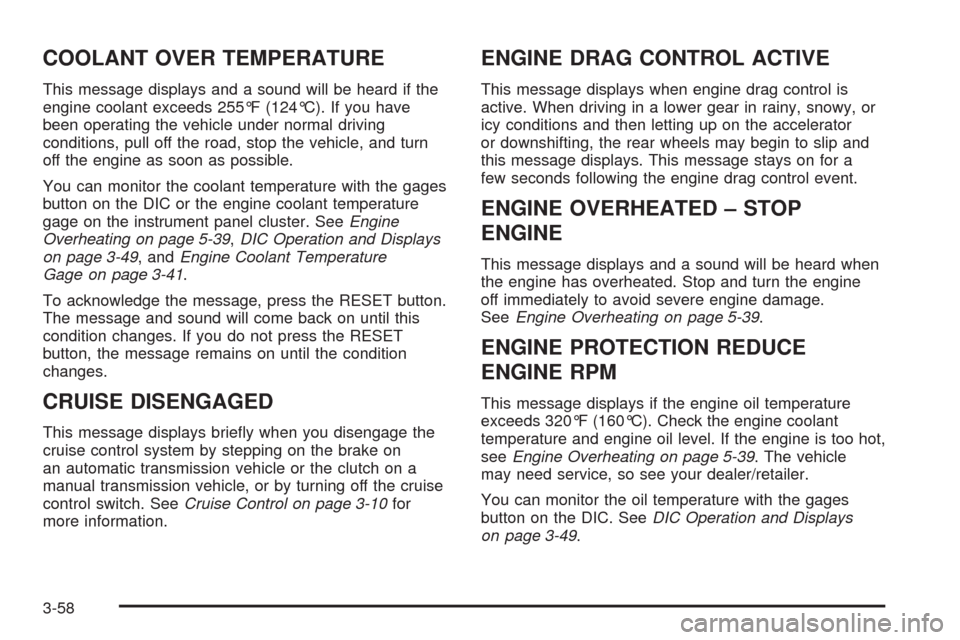
COOLANT OVER TEMPERATURE
This message displays and a sound will be heard if the
engine coolant exceeds 255°F (124°C). If you have
been operating the vehicle under normal driving
conditions, pull off the road, stop the vehicle, and turn
off the engine as soon as possible.
You can monitor the coolant temperature with the gages
button on the DIC or the engine coolant temperature
gage on the instrument panel cluster. SeeEngine
Overheating on page 5-39,DIC Operation and Displays
on page 3-49, andEngine Coolant Temperature
Gage on page 3-41.
To acknowledge the message, press the RESET button.
The message and sound will come back on until this
condition changes. If you do not press the RESET
button, the message remains on until the condition
changes.
CRUISE DISENGAGED
This message displays brie�y when you disengage the
cruise control system by stepping on the brake on
an automatic transmission vehicle or the clutch on a
manual transmission vehicle, or by turning off the cruise
control switch. SeeCruise Control on page 3-10for
more information.
ENGINE DRAG CONTROL ACTIVE
This message displays when engine drag control is
active. When driving in a lower gear in rainy, snowy, or
icy conditions and then letting up on the accelerator
or downshifting, the rear wheels may begin to slip and
this message displays. This message stays on for a
few seconds following the engine drag control event.
ENGINE OVERHEATED – STOP
ENGINE
This message displays and a sound will be heard when
the engine has overheated. Stop and turn the engine
off immediately to avoid severe engine damage.
SeeEngine Overheating on page 5-39.
ENGINE PROTECTION REDUCE
ENGINE RPM
This message displays if the engine oil temperature
exceeds 320°F (160°C). Check the engine coolant
temperature and engine oil level. If the engine is too hot,
seeEngine Overheating on page 5-39. The vehicle
may need service, so see your dealer/retailer.
You can monitor the oil temperature with the gages
button on the DIC. SeeDIC Operation and Displays
on page 3-49.
3-58
Page 196 of 434
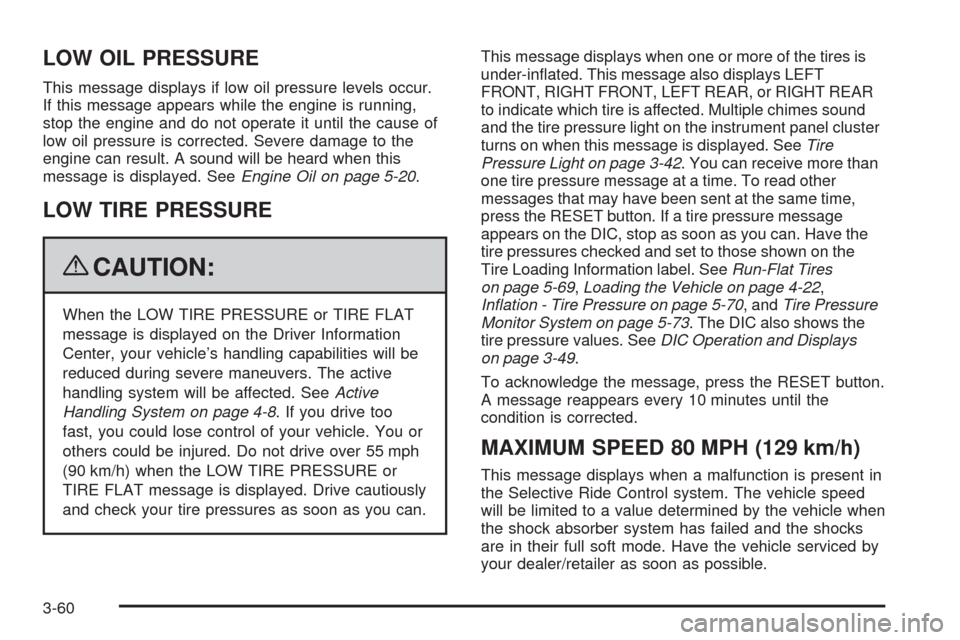
LOW OIL PRESSURE
This message displays if low oil pressure levels occur.
If this message appears while the engine is running,
stop the engine and do not operate it until the cause of
low oil pressure is corrected. Severe damage to the
engine can result. A sound will be heard when this
message is displayed. SeeEngine Oil on page 5-20.
LOW TIRE PRESSURE
{CAUTION:
When the LOW TIRE PRESSURE or TIRE FLAT
message is displayed on the Driver Information
Center, your vehicle’s handling capabilities will be
reduced during severe maneuvers. The active
handling system will be affected. SeeActive
Handling System on page 4-8. If you drive too
fast, you could lose control of your vehicle. You or
others could be injured. Do not drive over 55 mph
(90 km/h) when the LOW TIRE PRESSURE or
TIRE FLAT message is displayed. Drive cautiously
and check your tire pressures as soon as you can.This message displays when one or more of the tires is
under-in�ated. This message also displays LEFT
FRONT, RIGHT FRONT, LEFT REAR, or RIGHT REAR
to indicate which tire is affected. Multiple chimes sound
and the tire pressure light on the instrument panel cluster
turns on when this message is displayed. SeeTire
Pressure Light on page 3-42. You can receive more than
one tire pressure message at a time. To read other
messages that may have been sent at the same time,
press the RESET button. If a tire pressure message
appears on the DIC, stop as soon as you can. Have the
tire pressures checked and set to those shown on the
Tire Loading Information label. SeeRun-Flat Tires
on page 5-69,Loading the Vehicle on page 4-22,
Inflation - Tire Pressure on page 5-70, andTire Pressure
Monitor System on page 5-73. The DIC also shows the
tire pressure values. SeeDIC Operation and Displays
on page 3-49.
To acknowledge the message, press the RESET button.
A message reappears every 10 minutes until the
condition is corrected.
MAXIMUM SPEED 80 MPH (129 km/h)
This message displays when a malfunction is present in
the Selective Ride Control system. The vehicle speed
will be limited to a value determined by the vehicle when
the shock absorber system has failed and the shocks
are in their full soft mode. Have the vehicle serviced by
your dealer/retailer as soon as possible.
3-60